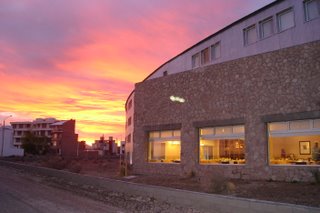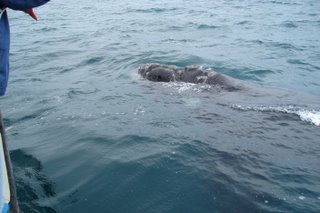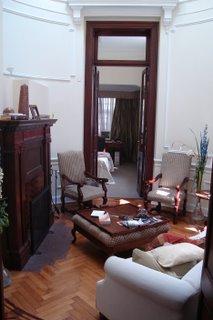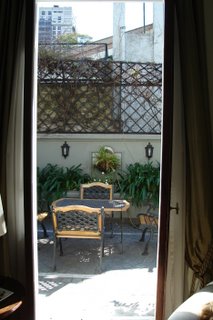Well, the halcyon days at the Casa are over - our 51
ninos arrived on Tuesday morning. The students had the same flights that we had from LA, and thus arrived in Buenos Aires at about 7:30 in the morning. Considering that they had flown all night, and changed planes in Lima, most of them were fairly chipper. The morning air was brisk, which seemed to come as a shock to some - hey, it's winter here! After Luz, Maria and Rafa greeted everyone and checked them in, we boarded two buses for the trip to the Casa. Similar to the busy first day that we had, the students' day was filled with paperwork, orientation, and of course an
asado. The real highlight of the day began at 5:00 when the homestay parents started to arrive to pick up their students. It was interesting to watch the level of anxiety rise as the time drew near, and I believe without exception, each student was feeling some apprehension. Many of the students had gone to a nearby vendor to get flowers as a welcome gesture for their new mommas and papas. And, without exception, all anxiousness disappeared as one by one, a host would be brought to the doorway, a student would be called forth, hugs exchanged, suitcases gathered, and the new family would head home. It really was exceptional, and exciting, for us to watch the beginning of what will no doubt be an unforgettable learning experience for each student.
One of the first things that the students have to adjust to is the daily routine of the Argentine families, e.g. dinner at 9:00 pm. The host families provide breakfast and dinner, and the classes are scheduled between 9 am and 6:00 pm. However, our classes do not begin until September 22. Until then, our time will be filled with an orientation tour of the city and our neighborhood, lectures on the history and culture of Argentina, and language 'boot camp' which is intended to get everyone beginning to think and speak Spanish, and to get accustomed to hearing the "zh_" pronunciation for the 'y' and 'll' words -
cinco de Mazho (Mayo), Ozheros (Olleros), zho (yo), como se zhama - you get the idea. Thursday and Friday were filled with culture and language classes, and then the weekend - well, you can probably guess where most of the students spent some of their time on the weekend. Buenos Aires is rather noted for the club scene, and I think that most of the kids got introduced to the night life - a different type of culture and language experience! Monday and Tuesday will again be culture and language classes, and then we leave for our fall semester educational field trip to Ushuaia and the Valdez Peninsula.
Rhonda and Doug's weekend time was much more sedate - a run in the park,
cafe y postres, riding the subte to different parts of the city to explore the shops, cafes, and
mercados pulgas. We were told of a large antique market in San Telmo on Sundays, so we made our way there via subte and foot. We did not know exactly where we were going, but that usually does not stop us - and we indeed found it close to where we thought it would be! It was an impressive experience. It's Sunday evening now, and some of the kids are going to
Rey de Reyes for worship, and we will gather here at the Casa with others who wish to spend some time in singing, reflection and prayer.












 Sra. Lili y Sr. Angel M. de Estrada
Sra. Lili y Sr. Angel M. de Estrada



